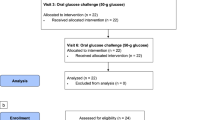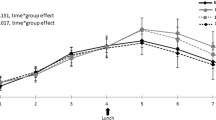Abstract
Background/ Objectives:
There has been growing interest in using dietary intervention to improve the lipid profile. This work aims at analyzing the effects and the comparison of the enrichment of a diet with beta-glucans or rice bran in mildly hypercholesterolemic men.
Subjects/Methods:
The subjects initially consumed a 3-week Step 1 American Heart Association diet with rice bran-enriched foods. After this adaptation period, volunteers were randomly assigned to follow a crossover, controlled trial that consisted of two treatment with beta-glucan- or rice bran-enriched foods, each of 4 weeks, with a 3-week wash-out, like the adaptation period, between periods. Fasted blood samples were collected on days 0, 21, 49, 70 and 98 in both study arms for measuring low-density lipoprotein (LDL)-cholesterol (primary outcome), total cholesterol, high-density lipoprotein (HDL)-cholesterol, triglycerides, apolipoprotein (apo) A-I, apo B and glucose levels.
Results:
Twenty-four men (mean age: 50.3±5.3, mean body mass index: 24.9±1.9) completed the 14-week trial. Subjects in the 3-week adaptation period experienced significant reductions in the mean level of LDL cholesterol, total cholesterol, total cholesterol/HDL cholesterol, LDL cholesterol/HDL cholesterol, apo A-I, apo A-I/apo B and glucose. During the intervention diet periods, a difference was found between treatment groups for the mean change in LDL (0.21 (95% confidence interval (CI): 0.02–0.40), P=0.033) and total cholesterol (0.34 (95% CI: 0.20–0.47), P<0.001). Other parameters evaluated were not significantly affected by the diet consumed.
Conclusions:
The results of the present crossover clinical trial showed that beta-glucan-enriched foods are more effective in lowering serum LDL levels, compared with rice bran-enriched foods.
This is a preview of subscription content, access via your institution
Access options
Subscribe to this journal
Receive 12 print issues and online access
$259.00 per year
only $21.58 per issue
Buy this article
- Purchase on Springer Link
- Instant access to full article PDF
Prices may be subject to local taxes which are calculated during checkout

Similar content being viewed by others
References
Agachan F, Chen T, Pfeifer J, Reissman P, Wexner SD (1996). A constipation scoring system to simplify evaluation and management of constipated patients. Dis Colon Rectum 39, 681–685.
American Heart Association (1988). Dietary guidelines for healthy American adults. A statement for physicians and health professional by the Nutrition Committee. Circulation 77, 721A–724A.
Anderson JW (1987). Dietary fiber, lipids and atherosclerosis. Am J Cardiol 60, 17G–22G.
Avellone G, Di Garbo V, Cordova R, Panno AV, Verga S, Bompiani G (1997). Food habits and cardiovascular risk factors in 2 population samples of western Sicily. Ann Ital Med Int 12, 210–216.
Behall KM, Scholfield DJ, Hallfrisch J (2004). Diets containing barley significantly reduce lipids in mildly hypercholesterolemic men and women. Am J Clin Nutr 80, 1185–1193.
Brown L, Rosner B, Willett WW, Sacks FM (1999). Cholesterol-lowering effects of dietary fiber: a meta-analysis. Am J Clin Nutr 69, 30–42.
Burkitt DP, Walker AR, Painter NS (1974). Dietary fiber and disease. JAMA 229, 1068–1074.
Cheng HH, Huang HY, Chen YY, Huang CL, Chang CJ, Chen HL et al. (2010). Ameliorative effects of stabilized rice bran on type 2 diabetes patients. Ann Nutr Metab 56, 45–51.
Drozdowski LA, Reimer RA, Temelli F, Bell RC, Vasanthan T, Thomson AB (2010). Beta-glucan extracts inhibit the in vitro intestinal uptake of long-chain fatty acids and cholesterol and down-regulate genes involved in lipogenesis and lipid transport in rats. J Nutr Biochem 21, 695–701.
Food and Drug Administration (2005). Food Labeling: Health Claims; Soluble Dietary Fiber From Certain Foods and Coronary Heart Disease; Final Rule. US Department of Health and Human Services: Rockville, MD. Available at http://vm.cfsan.fda.gov/_lrd/fr970123.html.
Frisancho AR (1984). New standards of weight and body composition by frame size and height for assessment of nutritional status of adults and the elderly. Am J Clin Nutr 40, 808–819.
Grundy SM, Cleeman JI, Merz CN, Brewer Jr HB, Clark LT, Hunninghake DB et al. (2004). Implications of recent clinical trials for the National Cholesterol Education Program Adult Treatment Panel III guidelines. Circulation 110, 227–239.
Jenkins DJ, Kendall CW, Vuksan V, Vidgen E, Parker T, Faulkner D et al. (2002). Soluble fiber intake at a dose approved by the US Food and Drug Administration for a claim of health benefits: serum lipid risk factors for cardiovascular disease assessed in a randomized controlled crossover trial. Am J Clin Nutr 75, 834–839.
Keogh GF, Cooper GJ, Mulvey TB, McArdle BH, Coles GD, Monro JA et al. (2003). Randomized controlled crossover study of the effect of a highly beta-glucan-enriched barley on cardiovascular disease risk factors in mildly hypercholesterolemic men. Am J Clin Nutr 78, 711–718.
Keys A, Anderson JT, Grande F (1960). Diet-type (fats constant) and blood lipids in man. J Nutr 70, 257–266.
Kirby RW, Anderson JW, Sieling B, Rees ED, Chen WJ, Miller RE et al. (1981). Oat-bran intake selectively lowers serum low-density lipoprotein cholesterol concentrations of hypercholesterolemic men. Am J Clin Nutr 35, 824–829.
Kostapanos MS, Milionis HJ, Elisaf MS (2010). Rosuvastatin-associated adverse effects and drug–drug interactions in the clinical setting of dyslipidemia. Am J Cardiovasc Drugs 10, 11–28.
Kottke TE, Puska P, Salonen JT, Tuomilehto J, Nissinen A (1985). Projected effects of high-risk versus population-based prevention strategies in coronary heart disease. Am J Epidemiol 121, 697–704.
Lia A, Hallmans G, Sandberg AS, Sundberg B, Aman P, Andersson H (1995). Oat beta-glucan increases bile acid excretion and a fiber-rich barley fraction increases cholesterol excretion in ileostomy subjects. Am J Clin Nutr 62, 1245–1251.
Marlett JA, Hosig KB, Vollendorf NW, Shinnick FL, Haack VS, Story JA (1994). Mechanism of serum cholesterol reduction by oat bran. Hepatology 20, 1450–1457.
McIntosh GH, Whyte J, McArthur R, Nestel PJ (1991). Barley and wheat foods: influence on plasma cholesterol concentrations in hypercholesterolemic men. Am J Clin Nutr 53, 1205–1209.
National Cholesterol Education Program (NCEP) Expert Panel on Detection, Evaluation and Treatment of High Blood Cholesterol in Adults (Adult Treatment Panel III) (2002). Third Report of the National Cholesterol Education Program (NCEP) Expert Panel on Detection, Evaluation and Treatment of High Blood Cholesterol in Adults (Adult Treatment Panel III) final report. Circulation 106, 3143–3421.
Qureshi AA, Mo H, Packer L, Peterson DM (2000). Isolation and identification of novel tocotrienols from rice bran with hypocholesterolemic, antioxidant, and antitumor properties. J Agric Food Chem 48, 3130–3140.
Reihner E, Angelin B, Rudling M, Ewerth S, Bjorkhem I, Einarsson K (1990). Regulation of hepatic cholesterol metabolism in humans: stimulatory effects of cholestyramine on HMG-CoA reductase activity and low density lipoprotein receptor expression in gallstone patients. J Lipid Res 31, 2219–2226.
Rivellese AA, Boemi M, Cavalot F, Castigliola L, De Feo P, Miccoli R et al. (2008). Dietary habits in type II diabetes mellitus: how is adherence to dietary recommendations? Eur J Clin Nutr 62, 660–664.
Shimizu C, Kihara M, Aoe S, Araki S, Ito K, Hayaski K et al. (2008). Effect of high β-glucan barley on serum cholesterol concentrations and visceral fat area in Japanese men—a randomized, double-blinded, placebo-controlled trial. Plants Foods Hum Nutr 63, 21–25.
Sugano M, Koba K, Tsuji E (1999). Health benefits of rice bran oil. Anticancer Res 19, 3651–3657.
Talati R, Baker WL, Pabilonia MS, White CM, Coleman CI (2009). The effects of barley-derived soluble fiber on serum lipids. Ann Fam Med 7, 157–163.
Trowell HC (1975). Dietary-fiber hypothesis of the etiology of diabetes mellitus. Diabetes 24, 762–765.
Ware JE, Snow KK, Kosinski M, Gandek B (1993). SF-36 Health Survey: Manual and Interpretation Guide. The Health Institute: Boston, MA.
Wilson TA, Nicolosi RJ, Woolfrey B, Kritchevsky D (2007). Rice bran oil and oryzanol reduce plasma lipid and lipoprotein cholesterol concentrations and aortic cholesterol ester accumulation to a greater extent than ferulic acid in hypercholesterolemic hamsters. J Nutr Biochem 18, 105–112.
Acknowledgements
We are grateful to the volunteers for their participation and commitment to the study, to Francesca Mendozza (Riso Scotti) for her coordination in the intervention foods preparation and to Marco Caspani (DKSH Italia s.r.l.) and Tom Jorgens (PolyCell Technologies) for their linguistic and conceptual revision.
Author information
Authors and Affiliations
Corresponding author
Ethics declarations
Competing interests
The authors declare no conflict of interest.
Rights and permissions
About this article
Cite this article
Rondanelli, M., Opizzi, A., Monteferrario, F. et al. Beta-glucan- or rice bran-enriched foods: a comparative crossover clinical trial on lipidic pattern in mildly hypercholesterolemic men. Eur J Clin Nutr 65, 864–871 (2011). https://doi.org/10.1038/ejcn.2011.48
Received:
Revised:
Accepted:
Published:
Issue Date:
DOI: https://doi.org/10.1038/ejcn.2011.48
Keywords
This article is cited by
-
The effects of rice bran supplementation for management of blood lipids: A GRADE-assessed systematic review, dose–response meta-analysis, and meta-regression of randomized controlled trials
Systematic Reviews (2023)
-
Plantain based dough meal: nutritional property, antioxidant activity and dyslipidemia ameliorating potential in high-fat induced rats
Clinical Phytoscience (2021)
-
A systematic review and meta-analysis of randomized controlled trials of the effect of barley β-glucan on LDL-C, non-HDL-C and apoB for cardiovascular disease risk reductioni-iv
European Journal of Clinical Nutrition (2016)



